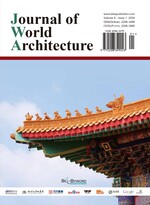Abstract
This paper discusses ancestral hall architecture within the context of the Cantonese folk lineage in the Pearl River Delta. Using a typological research approach and chronological analysis, various factors that have influenced the evolution of ancestral hall architecture are analyzed. The study specifically investigates the features of ancestral halls during the Ming and Qing dynasties. Three periods of ancient China are analyzed: The transition from Ming to Qing, the mid-Qing dynasty, and the late Qing dynasty. The variables of each period and how they influence the evolution of architectural typological features are identified. Based on our analysis, architectural features are related to economic and social factors, materials available, and craftsmanship of the construction workers.
References
Jiang F, 2010, Cultivation, Lineage Settlements and Transition of Ancestral Halls in Canton Prefecture During Ming and Qing Dynasty, dissertation, South China University of Technology.
Jian W, 2002, A Study of the Architecture and Culture of the Folk Houses of the Guangfu Folk Lineage, dissertation, South China University of Technology.
Jiang F, 2010, In the Name of Forefathers: on the Traditional Kinship-Based Settlements and Ancestral Halls in Canton Prefecture during the Ming and Qing Dynasties, China Architecture & Building Press, Beijing.
Qu J, 2018, Exploring the Architectural Characteristics of Guangfu Ancestral Halls from the Perspective of Regional Culture: Taking the Ancestral Halls of Yangyu Village in Huadu as an Example. Beauty & Times, 2018(4): 26–27.
Liu Z, 2006, From the History of Local Aristocrats to the Memoirs of Scholar-Officials: The Shift of Local Power in the Ming Dynasty as Seen from A Memoir of My Forefathers by Huang Zuo. Historical Research, 2006(06): 49–69 + 190.
Chang J, 2001, Of the Establishment of the System of Offering Sacrifices to Ancestors and the Building of Ancestral Hall in the Ming Dynasty and Their Evolution. Nankai Journal, 2018(3): 60–67.
Liu Z, Yuan Y, 1998, An Analysis of Clan Organisation in Ming Dynasty Guangdong. Guangdong History and Historical Records, 1998(1): 2-6.
Ye H, 2000, Social and Clan Culture in the Lingnan Region During the Mid and Late Periods of the Ming Dynasty. Historical Research, 2000(3): 15-30+189.
Qu D, 1985, Cantonese Novelty, Zhonghua Book, Beijing.
Yang Y, 2013, The Architectural Form Study of Ancestral Halls in Canton, dissertation, South China University of Technology.
Chen H, 2005, A General History of Chinese Customs - Ming Dynasty Volume, Shanghai Literature & Art Publishing House, Shanghai, 265.
Shang B, Pan B, 1988, Addition to the Qing Dynasty Record of Novels by the Ming Dynasty, Guangxi Nationalities Publishing House, Liucheng, 60.
Luo Y, 1994, Economic Development and Social Changes in Foshan during the Ming and Qing Dynasties, Guangdong People’s Publishing House, Guangzhou, 321.
Yan X, Wei Q, 1997, Characteristics of Clan Ethics and Clan System in the Pearl River Delta from Genealogical Perspective. Academic Research, 1997(12): 41–46.
Jiang Z, 1995, Concise History of Guangdong, Guangdong People’s Publishing House, Guangzhou.
Lai Y, 2011, Research on Ancestral Halls of Guangfu Clan in Pearl River Delta, dissertation, South China University of Technology.
